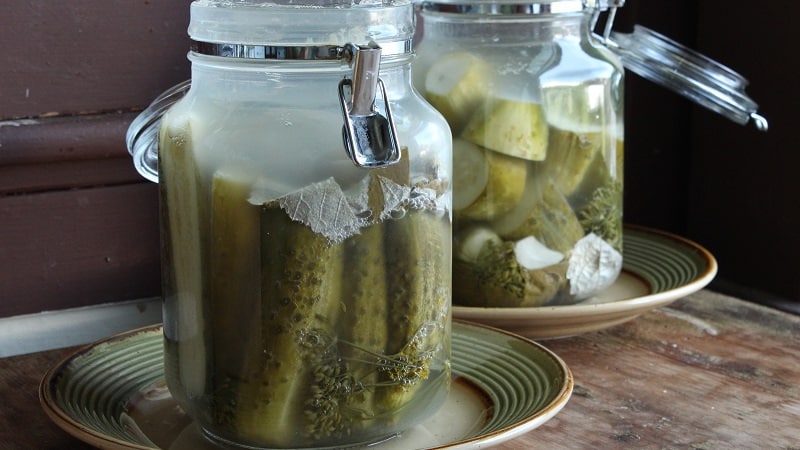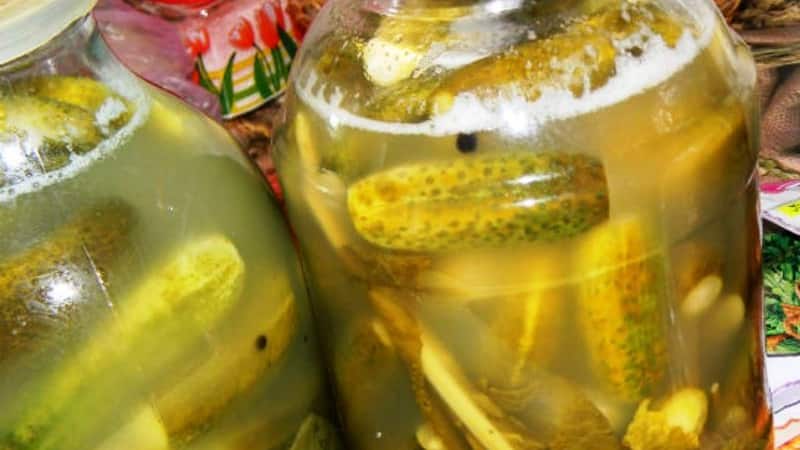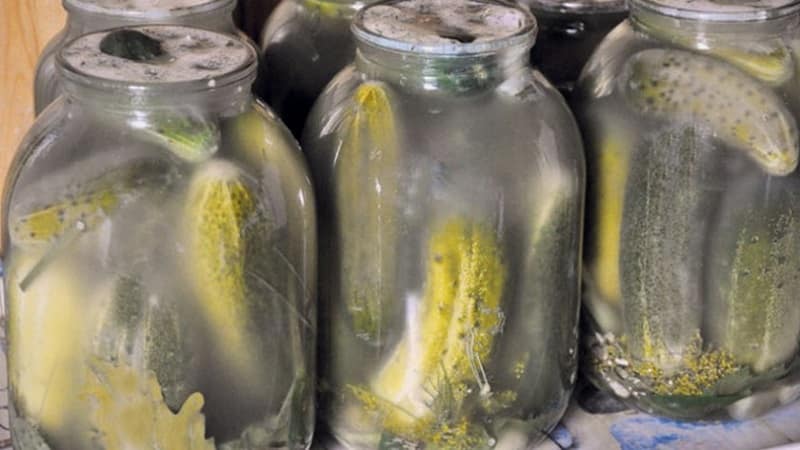Why mold might appear on pickled cucumbers and what to do about it
It happens that you spend a lot of time and effort on pickling cucumbers, and after a few weeks or months you discover that they have spoiled. The brine became cloudy and mold appeared on its surface. How to distinguish dangerous mold from harmless plaque? Next, we will talk about this, and also reveal the secrets of how to prepare and store cucumbers so that mold does not appear on them in the future.
White coating on pickles - mold or not
Subject to preservation technology and storage rules, pickled cucumbers should not spoil. If a white coating appears on them, this is normal and should not be a concern. But it is possible that mold has formed on the cucumbers and they have changed their properties - then by eating such a product, you are risking your health. There are a number of signs by which you can determine how hopelessly damaged the workpieces are.

First you need to know exactly what recipe the cucumbers were prepared according to.. If without adding vinegar or a similar preservative, without acid, only with salt, then the cloudiness of the brine and the appearance of a white coating is a natural process of formation of lactic acid. Subsequently, the cloudy sediment sinks to the bottom, and the brine becomes more transparent.
In what cases is it botulism?
Botulism is a serious disease caused by putrefactive fungi, releasing a toxic, lethal substance to humans, botulinum toxin.The main danger of this toxin is that its presence in homemade preparations cannot be determined by color, smell or taste.
Bacteria are not destroyed by most conventional disinfection methods., can develop in an airless environment, in hermetically sealed jars. They are not killed by adding table vinegar or table salt to canned food. It is very difficult to get rid of botulinum spores at home.
Preventive measures include maintaining cleanliness during preparation.
The only way to protect yourself is heat treatment. When canning, this means thoroughly boiling the jars and lids; after opening the jars, they are heated in boiling water for up to 30 minutes to destroy the toxin.
Interesting things on the site:
Why does a white coating appear on pickled cucumbers?
In what cases is it lactic acid?
The white coating that appears on pickled and canned vegetables is lactic acid bacteria, a fermentation product. The presence of these bacteria indicates that fermentation processes are underway..

Fermented foods are a source of natural probiotics. Lactic acid bacteria help fight the development of pathogenic microflora in the intestines. If the cucumbers have not changed their smell and remain hard to the touch, wash off the white coating and eat the vegetables.
But if the appearance of plaque is accompanied by swelling of the can, an unpleasant odor when opening and softening of products is an alarming sign. These cucumbers should not be eaten.
When can cucumbers be saved?
Before you throw away your pickles, you should first find out if they can be saved.
How to determine the suitability of cucumbers for consumption
Workpieces that retain the following characteristics remain suitable::
- little mold;
- cucumbers are strong, elastic, not soft;
- The smell of brine is natural, not putrid.
In this case, after some actions, you can continue storage.
What to do with these cucumbers
The mold is removed, the vegetables are washed to remove plaque, and placed in a clean, sterilized jar. and fill with new brine. After this, put it in a cool place.
If cucumbers are stored in a barrel or other large container (pan, bucket), you can rinse or throw away only those that were in the top layer. Then add fresh brine and add mustard powder.
It is not recommended to store such preparations for a long time., it is better to process them as quickly as possible, using them for preparing hot dishes (pickle soup, pizza).

Causes of mold on pickled cucumbers
The main reason for damage to homemade products is violation of conservation technology or failure to maintain cleanliness. All products used must be thoroughly washed, jars and lids sterilized. Any dirt that gets inside can trigger the process of putrefactive fermentation and mold formation.
Violation of the recipe and the use of inappropriate ingredients may also be the cause.. Salad cucumbers are not intended for long-term storage and are not suitable for canning; you need to choose special varieties for pickling. Carefully ensure that the vegetables are fresh and without signs of rot.
Attention! It is not recommended to use iodized salt instead of table salt.
The cause of damage to workpieces There may be a lack of salt, as well as non-compliance with storage rules.
How to properly pickle and seal cucumbers to prevent mold from appearing on them
There are two ways to pickle cucumbers: hot and cold.. In the first case, they are filled with hot brine, rolled up with iron lids, after which the jars are stored at room temperature. In the second, they are filled with cold water, covered with nylon lids and stored in the refrigerator or cellar.
Advice. To prevent white plaque or mold from appearing, when salting, add dry mustard and place horseradish root or raspberry leaves on top.
Before spinning the cucumbers, the jars are sterilized.:
- potassium permanganate solution;
- ferry;
- by boiling;
- in the microwave;
- in an electric oven.

Before sterilizing, make sure that jars and lids are intact.: there are no chips on the glass, the iron covers are not deformed. Before the procedure, wash them with laundry soap.
Read also:
Rules for storing pickled cucumbers
Cans with blanks are held in a dark, cool place. Barrel pickles are stored at a temperature of about 0°C, observing the following conditions:
- the brine completely covers the cucumbers;
- they are under oppression;
- the temperature is constant, without sudden changes.
Sometimes pickles are stored frozen. To do this, they are removed from the brine, excess moisture is removed, portioned into containers or bags and placed in the freezer. Afterwards it is better to subject them to heat treatment - add them to hodgepodge, rassolnik or pizza.
Barrel pickles can be stored in containers, after washing them, drying them and sprinkling each layer with mustard powder.
Is it possible to eat pickles if they have mold on them?
Mold appears as spots or islands on the surface of the brine, can cover the entire space under the lid of the jar with a cap.It appears as a result of ingestion of contamination or infection.

If at the same time the jar swells, the cucumbers become soft, slippery, or smell bad - throw them away, without hesitation: they can seriously poison you. Moldy foods should not be eaten.
Conclusion
If you are not sure of the quality of homemade products, it is better not to risk your health and not eat them. Follow the salting and storage technology, follow simple sterilization recommendations, and then mold will not appear.
There is no cloudiness in the brine in the jar of cucumbers. but floating on top, white on top and gray-black inside, is a strong, almost rubbery thing with a diameter of approx. 4 cm. I tore it up and looked at it. After half an hour she deflated. Has anyone encountered this? I’ve been canning cucumbers for 20 years now. This is the first time I’ve encountered this. Can answer? Thank you.